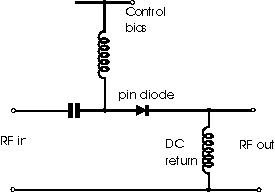The PIN diode
- for switching microwave, and photo diode applications
PIN diodes (p-i-n diodes) are used in many electronics applications, and in
particular PIN diodes find uses in electronic switching applications. However it
found its first applications in 1952 as a low frequency high power rectifier.
The PIN diode is also used in a number of microwave applications, although it
took until around 1960 before its use became more popular in this application. A
further use is as a photo-detector (photodetector or photo-diode) where its
structure is particularly suited to absorbing light.
Structure
The PIN diode consists of a semiconductor diode with three layers. The usual P
and N regions are present, but between them is a layer of intrinsic material a
very low level of doping. This may be either N-type or P-type, but with a
concentration of the order of 13^13 cm^-3 which gives it a resistivity of the
order of one k-ohm cm.
The thickness of the intrinsic layer is normally very narrow, typically
ranging from 10 to 200 microns. The outer P and N-type regions are then heavily
doped.
There are two ways in which the PIN diode can be realised. One is to
fabricate the p-i-n diode in a planar structure, and the other is to use a mesa
structure. When the planar structure is fabricated an epitaxial film is grown
onto the substrate material and the P+ region is introduced either by diffusion
or ion implantation. The mesa structure has layers grown onto the substrate.
These layers have the dopants incorporated. In this way it is possible to
control the thickness of the layers and the level of dopants more accurately and
a very thin intrinsic layer can be fabricated if required. This is ideal for
high frequency operation. A further advantage of the mesa structure is that it
provides a reduced level of fringing capacitance and inductance as well as an
improved level of surface breakdown.

PIN diode with a planar construction
PIN diodes are widely made of silicon, and this was the semiconductor
material that was used exclusively until the 1980s when gallium arsenide was
introduced.
Characteristics
The main feature of the PIN diode is the intrinsic layer between the P-type and
N-type regions. This enables it to provide properties such as a high reverse
breakdown voltage, and a low level of capacitance. For microwave applications it
offers carrier storage when it is forward biased.
It is found that at low levels of reverse bias the depletion layer become
fully depleted. Once fully depleted the p-i-n diode capacitance is independent
of the level of bias because there is little net charge in the intrinsic layer.
When the PIN diode is forward biased both types of current carrier are
injected into the intrinsic layer where they combine. It is this process that
enables the current to flow across the layer.
The particularly useful aspect of the PIN diode occurs when it is used with
high frequency signals, the diode appears as a resistor rather than a non linear
device, and it produces no rectification or distortion. Its resistance is
governed by the DC bias applied. In this way it is possible to use the device as
an effective RF switch or variable resistor producing far less distortion than
ordinary PN junction diodes.
Applications
The PIN diode is used in a variety of different applications from low
frequencies up to high radio frequencies. The properties introduced by the
intrinsic layer make it suitable for a number of applications where ordinary PN
junction diodes are less suitable.
In the first instance the diode can be used as a power rectifier. Here the
intrinsic layer gives it a high reverse breakdown voltage, and this can be used
to good effect in many applications.
Although the p-i-n diode finds many applications in the high voltage arena,
it is probably for radio frequency applications where it is best known. The fact
that when it is forward biased, the diode is linear, behaving like a resistor,
can be put to good use in a variety of applications. It can be used as a
variable resistor in a variable attenuator, a function that few other components
can achieve as effectively. The PIN diode can also be used as an RF switch. In
the forward direction it can be biased sufficiently to ensure it has a low
resistance to the RF that needs to be passed, and when a reverse bias is applied
it acts as an open circuit, with only a relatively small level of capacitance.
Another useful application of the PIN diode is for use in RF protection
circuits. When used with RF, the diode normally behaves like a resistor when a
small bias is applied. Hover this is only true for RF levels below a certain
level. Above this the resistance drops considerably. Thus it can be used to
protect a sensitive receiver from the effects of a large transmitter if it is
placed across the receiver input.

PIN diode attenuator and switch circuit
Finally the PIN diode finds many applications as a photodiode, although this
will be explained separately.
|

